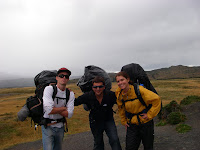
April 1, 2008: This morning, I woke up and put on my clothes. Long underwear and jeans. Long sleeve shirt, sweater, light jacket, down jacket. Thick socks and hiking boots. Gloves in my pocket along with a wool hat. Then I got on a plane and flew 1500 km south to Punta Arenas. upon arrival the weather was a nice 12C (50F). I didn't need my big puffy jacket yet. We hopped on a bus to Puerto Natales which was about 2 hours away. We were told to check out Erratic Rock hostel. So we did. They were full, but offered us a place at what they called Erratic Rock 0.5. They put some mats on the floor and we slept in our sleeping bags for the night. That night we packed for our week long camping trip. Dehydrated mashed potatoes and soups, some cheese, salami, bread, tea, powdered milk, sugar, trail mix, oatmeal premixed with powdered milk and nuts. Stove for heating water, fuel for stove. Mess kit of pots, spoons, knife. Sleeping bag, pad, 3 person tent. And all the warm clothes that you can wear.
Beginning: You have to pay to enter the park. You also have to pay at half the campsites. That seemed ridiculous, so we decided to only stay at the free campsites. We were warned that meant there were no bathrooms or rangers, but I always thought that was what camping was about. Being outside.
Day 1: Most people pay to take a catamaran half an hour to Camp Pehoé.

We walked six hours to avoid paying and stick to the free plan. Our bus dropped us off at the administration center in the southern part of the park. Hiking for only a couple of hours, we arrived at the first campsite,
Las Carretas. It was a few hundred meters from the river
Rio Grey (appropriately named if it was named for the color of the water) and seemed decent. There were piles of wood that we assumed were protection from the wind so we set up our tent next to one. The weather was good and there was no wind and we expected things to be pretty easy. We had a good dinner and went to bed early.
2:30 am: Mice are in the tent. The had chewed through the tent, through our backpacks and into our food. The wind is now at least 50 kmh and it is raining. We grab our stuff and run to the shelter 20 m

eters away. Because the campsite was closed (hence free) the bathrooms were locked and people had used the shelter as a bathroom.
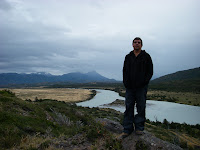
So we are standing in a shelter (think 3 walls and a roof with a picnic table) holding our backpacks, freezing, trying not to inhale. We know that we have about 6 hours of hiking ahead of us tomorrow and we consider starting now. We can't put our bags back in the tent, we can't stand here holding them all night, what else is there, but to start hiking? Luckily, a tiny bit of logic crept into my brain and we decided to put all of our food into one bag and hang it from the shelter. However, if the mice chewed the rope that supported the bag all of our food could be lost to rodents, foxes, feces, whatever. But we wanted to go to bed. We collapsed into our bags after hanging the food and woke up later than we wanted.
Day 2: Back in the stinky shelter, we made breakfast and tea and tried not to mention the weather. It was still windy and rainy and we had a long way to go. We eventually got everything together, saw what food was lost and began the hike to the next site. We walked northwest around Lago Pehoé to the fi
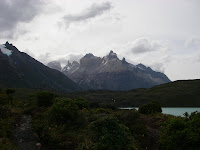
rst refugio. The refugios are like mini hotels. For about $40 you can stay the night in a bed, a warm, dry, bed. The even offer meals. $10 for breakfast, $20 for lunch and dinner. We used their shelter to make some soup and kept hiking northwest. The shelter at the refugios had four walls, free fuel, and pots and pans. Showers and bathrooms were also available, but those facilities were only supposed to be for the people that paid. The weather cleared and we got our first sight of the Torres. Inspired and enthusiastic once again, we set off for another free campsite. First though, we had to pass through another pay site.
As we approached the pay site, I saw my first glacier (Grey Glacier) and icebergs.

The ice broke off the glacier, floated down the lake (Lago Grey), melted and became Rio Grey. It was getting dark as we walked into the pay campsite. They also had hot showers, bathrooms, and a shelter. It was another uphill 2 hour hike to the free campsite and my companions couldn't resist the urge to drop the packs and make dinner. We sucked it up and paid $20 for a campsite for 3 of us. I wasn't complaining. We camped beside a glacier. That was impressive.

Day 3: We packed everything and back tracked a few hours to the pay campsite where we made lunch the previous day. We were hurting, but did another 3.5 hours to the free campsite
Italiano. It was beside another river that was made of glacial runoff. From there we collected water to make more soup, tea, and cheesy instant potatoes. The weather is still nice and although we are becoming more bruised, sore, and tired, we are happy and the idea that we are hiking around these stone giants is making us more determined with each step.
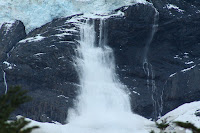
Day 4: Today was a great day. We left our big heavy backpacks in camp and hiked a couple of hours uphill through
Valle Frances, French Valley, to
Camparmento Britanico, the British Campsite. This place is very international. On our left, there were avalanches, rock slides, and icefalls that sounded like thunder. On our right, colossal towers were looming over us like skyscrapers. We were surrounded by the Torres del Paine. On our way back down to our camp, we stayed and watched avalanches for a while. We sat on rocks that had been carried to their current position by the glaciers that carved the valley. When we couldn't feel our butts anymore we returned to camp. Dinner was served early and then the rain started. We darted into our tent and hoped that the weather would clear before we had to start another long day.
Day 5: Rain. We woke up early anticipating about 8 hours of hiking. Of course if it were just hiking, it wouldn't be too bad. It is hiking sometimes gaining 1000 meters in elevation with at least 20 kilos in our backpacks. My back, knees, hips, everything hurt when I put on my pack.
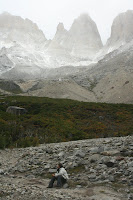
They were so heavy that we would have to help each other put them on. It was only 2 hours to our first
refugio and it rained continuously. We dried off as much as we could and had a snack in the
refugio. After a while we realized that we needed to get a move on. It was another four hours to the next stop, then two more to our final destination of the day. So we hoofed it. It rained, then got windier, then it rained some more. We were drenched. Nothing is waterproof in that kind of weather. Luckily, I put all of my stuff in a trash bag inside my backpack. My backpack was getting heavier by the minute as it soaked in the cold rain. After a few hours we were cold, miserable and grumpy. We stopped talking and got to the
refugio. Inside was like paradise. They had a fire going with lots of gloves, jackets, and hats drying around it.

We were able to sit down and relax for a bit. The weather was getting worse and we still had two more hours of uphill hiking to go. Talking to the people that were also sitting around the fire we found out that most of them had come from the campsite where we were trying to go. It was raining harder there and the clouds were preventing anyone from seeing any of the towers. We decided to stay at a lower elevation. The point of going up higher was to see the opposite side of the
torres than we had seen the day before. There was snow at the highest campsite. We paid for a campsite (after debating renting a bed) and went to sleep as it was still raining outside.
Day 6: We woke up and it was still raining. The snow line was lower than the day before and the temperature was also dropping. More people had come to the refugio. It was colder and the trail was full of snow. The clouds still prevented the towers from being seen. We decided to sit inside, have tea and wait for the bus back to Puerto Natales. All went as we planned for that day.
So in the end we hiked about 65 kilometers. Saw some things that we have never seen (Guanacos (think llama), Ñandus (like an ostrich), Andean Condors, glaciers, icebergs, avalanches, Torres del Paine), and got to fulfill one of my goals in life.
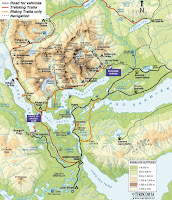
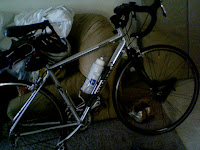 I arrived in Boulder to see cyclists and runners everywhere. I will be getting new running shoes soon so that I can run in the Bolder Boulder this year.
I arrived in Boulder to see cyclists and runners everywhere. I will be getting new running shoes soon so that I can run in the Bolder Boulder this year.  I also have my goggles so I can swim in the pools here. Pools are not my favorite, but the reservoir here is too cold for me.
I also have my goggles so I can swim in the pools here. Pools are not my favorite, but the reservoir here is too cold for me.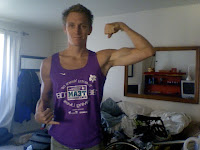 jersey for my running needs. Thanks guys!
jersey for my running needs. Thanks guys!















 eters away. Because the campsite was closed (hence free) the bathrooms were locked and people had used the shelter as a bathroom.
eters away. Because the campsite was closed (hence free) the bathrooms were locked and people had used the shelter as a bathroom. 